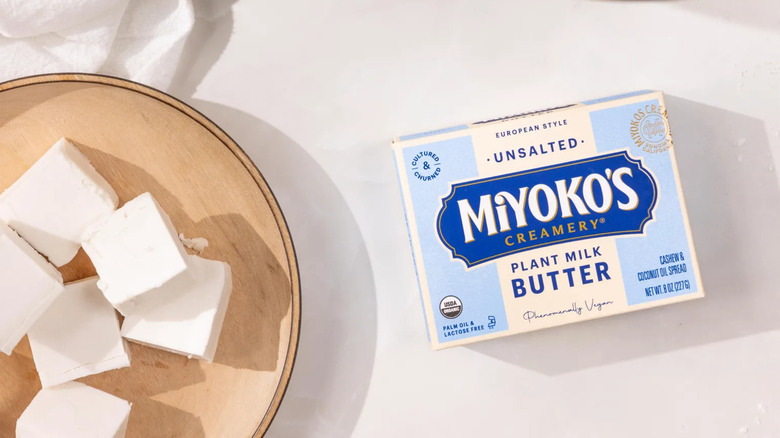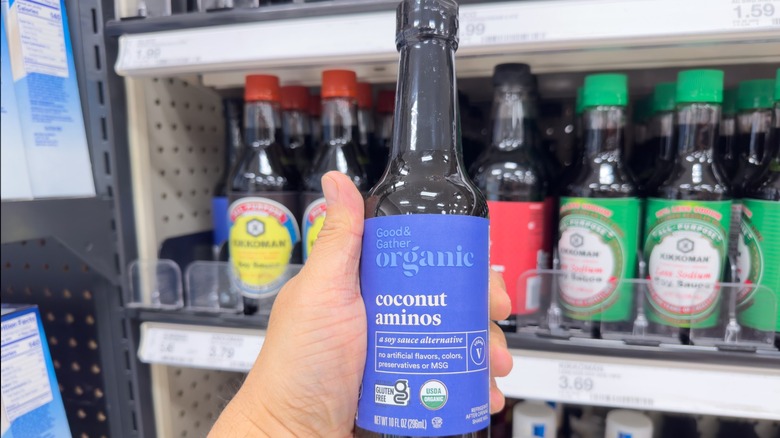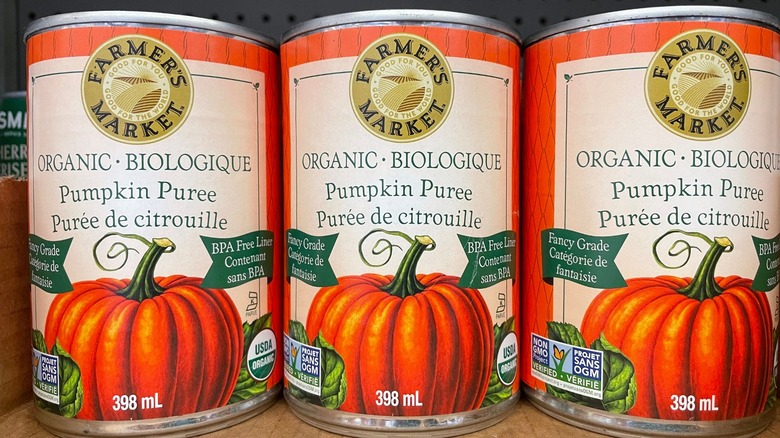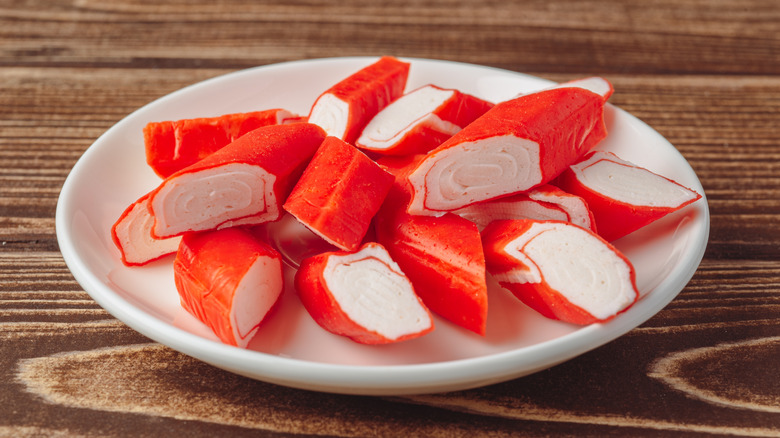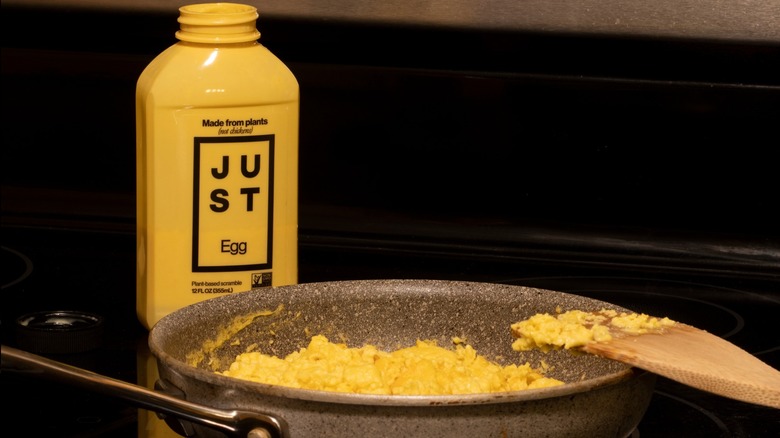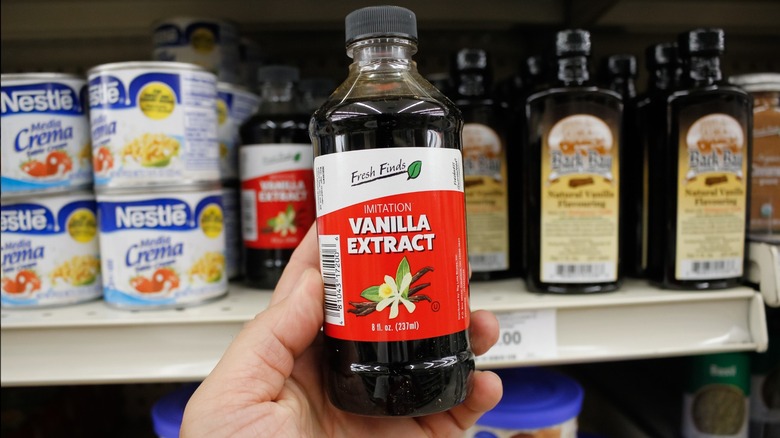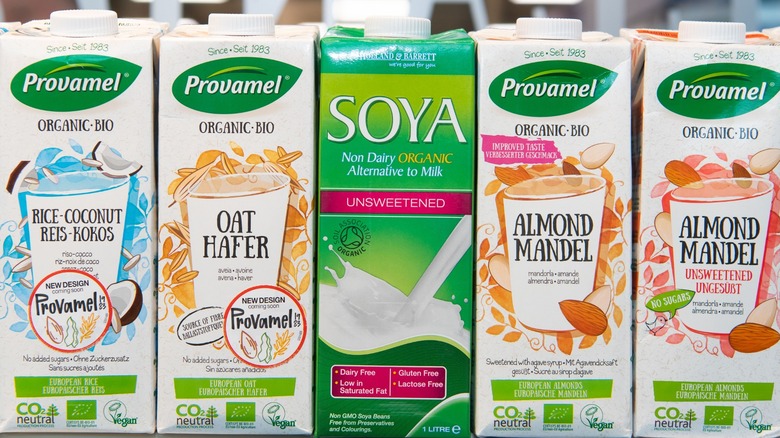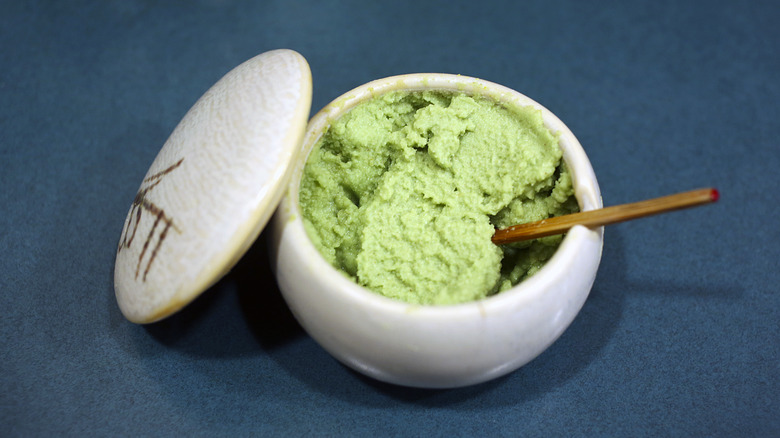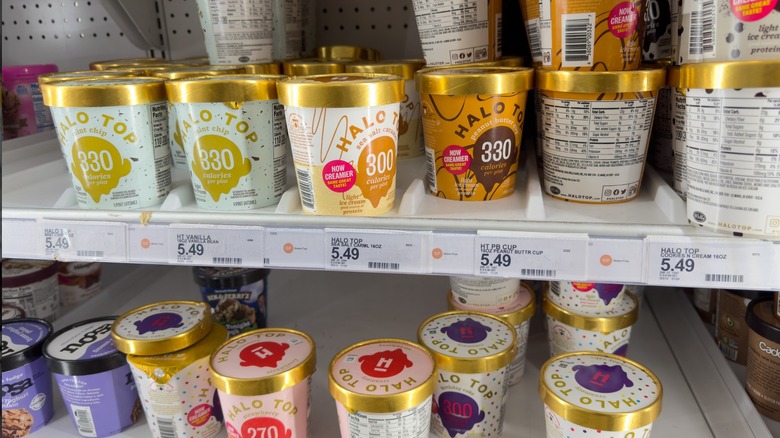9 Imitation Foods That Are Surprisingly Better Than The Real Thing
These days, you can find imitation food products of all kinds, from gluten-free pasta to peanut butter alternatives. This is great news if you have an allergy, intolerance, or simply don't like a certain food. However, not all fake foods are created equal. Some don't even come close to replicating the real thing. If you've tried certain vegan cheeses, you know what I'm talking about.
Ultimately, when it comes to imitation foods, it can be hard to tell the good from the bad. Of course, you could take the risk and try it yourself. But luckily, you don't have to. As a curious consumer, I've taste-tested several imitation products along with their real counterparts. To my surprise, many of these fake foods were superior. Some had a better taste or consistency while others were easier to cook with.
So which faux products are better than the real thing? You're about to find out. Below, I've listed my top nine choices along with the details of each. So keep reading to find one that piques your interest. And who knows? After conducting your own taste test, you might be surprised as well.
1. Plant-based butter
Vegans no longer have to say bye-bye to butter because many plant-based alternatives are actually incredible. These butters are made from plant oils such as olive, avocado, or palm kernel oil. However, one in particular stood out to me. Made from cashews and coconut oil, Miyokos Plant Milk Euro Butter has a rich creamy taste and perfect butter-like consistency. What's even better is it spreads just like butter would.
These sticks of butter have a whitish hue rather than a pale yellow, but don't let appearances fool you. It tastes similar to butter — if not better. And due to the coconut and cashew, it has a slight sweetness and a nutty undertone.
European butter is also churned longer than its American counterpart, resulting in butter with a higher fat content and fuller flavor. I'm not entirely sure how Miyokos processes its plant butter, but it replicates this style seamlessly. The brand's Euro butter comes in salted or unsalted sticks, depending on your preference. Because even in the world of plant-based butters, you've got options!
2. Coconut aminos
Are you avoiding gluten, but craving sushi? You're in luck! There's no need to skip that soy sauce because coconut aminos are a gluten-free alternative that tastes surprisingly good. They can be used interchangeably — and not only for sushi. Coconut aminos are a solid replacement in stir-fries, stews, soups, or marinades.
Both the imitation and the real thing contain salt and water. However, soy sauce is made with soybeans and wheat while coconut aminos are made with coconut blossom nectar. The aminos also tend to have about half as much sodium as the real thing. That being said, they still have that umami quality, but with a hint of sweetness thanks to the nectar, so you don't have to decide between salty or sweet. You can have the best of both worlds.
This imitation sauce is also denser than soy sauce so you can use less (and get more bang for your buck). Or, use the same quantity in your recipes to enjoy a richer, thicker consistency. So whether you're avoiding wheat, lowering your sodium, or just looking for a change from standard soy sauce, coconut aminos are the way to go.
3. Imitation pumpkin purée
Chances are, you've been eating imitation pumpkin purée without even knowing it. You see, the FDA allows pumpkin puree to be labeled as such even if it's made with another variety of squash — not solely pumpkin. However, pumpkin is in the squash family already, so using a squash blend doesn't detract from the purée's taste and texture. If anything, it only enhances it.
Companies often combine field pumpkin with sweet squash to achieve that classic pumpkin purée flavor. And since they have some leeway when making imitation versions, they can focus on creating a product that consumers love. As such, the consistency of imitation pumpkin purée is more reliable. So if you're using it in muffins, pies, or homemade pumpkin spice lattes, go for imitation brands.
When autumn arrives, you might be inspired to make homemade pumpkin purée. So should you stick with the pumpkin or use a squash blend? When going the pure pumpkin route, one Reddit user explains, "I tried it and found the extra work not worth it. The flavor was so similar, that by taste it was near the same. If you have such interest give it a try for yourself, but like one of my workmates says 'sometimes the juice isn't worth the squeeze.'" So when making purée, save some of those pumpkins for your doorstep and combine other squashes instead.
4. Imitation crab
Growing up, I had no idea imitation crab wasn't the real thing. Those slender strips of seafood with their waxy red coating look and taste like crab, so they must be crab, right? Wrong. And once you eat crab from the shell, you'll notice some stark differences. However, while real crab is delicious, the imitation version has some serious advantages.
For one, imitation crab has a much more approachable taste. It's made of surimi, a kind of paste made from pulverized fish, combined with binders like egg white or starch. This results in a mild fishy flavor and a soft gummy texture that's less messy than the real thing. Real crab meat is also flakier, which can be hard to cook with — not to mention much more expensive. Ultimately, fake crab meat is far easier to come by than the real stuff.
Plus, there are many tasty ways to use imitation crab meat, and you won't have to crack any shells. It makes a wonderful addition to dips, sandwiches, or egg salad. You can even use the fake stuff to make imitation crab cakes.
5. Imitation egg
If you thought it was impossible to imitate eggs, you'd be wrong. Plant-based egg products are popping up all over the place. And however you like your eggs, there's a plant-based product to suit your needs. If you like them hard-boiled, Wunder Egg has you covered. Prefer them fried? BeLeaf has an imitation fried egg you can eat on burgers, sandwiches, or on its own. And if you want eggs Benny, there are imitation poached eggs that somehow replicate the texture. But that's not all! For even more options, you can check out our list of the best plant-based egg products on the market.
However, if I'm being honest, I'd stick to imitation egg products in powder or liquid form. They do a much better job of nailing the flavor — and they taste incredible. JUST Eggs blew my mind with its fluffy texture and eggy flavor and was easier to cook than the real thing. You can't have your eggs sunny side up, but it does a great job of replicating scrambled eggs and omelets. Instead of eggs, it's made with mung bean protein and canola oil, and per serving, it has a similar macronutrient profile as a real egg. However, it has zero cholesterol, making it an eggcellent option if you're watching that cholesterol intake.
6. Imitation vanilla
Strolling down the baking aisle, you'll notice two versions of vanilla extract on store shelves: pure and imitation. So which one do you buy? Go for the imitation. Not only is it less expensive, but rumor has it that fake vanilla can withstand higher heat and it actually tastes better.
To test the difference between the two, I took a spoonful of each. Mind you, I wouldn't recommend this route — and can assure you — a spoonful of vanilla wouldn't help medicine go down. However, I found that pure vanilla has a stronger alcohol flavor. Imitation vanilla had a hint of spice and a slightly bitter aftertaste but was overall more palatable.
But let's be honest ... you're not going to be drinking the stuff straight. You're more likely to use vanilla in desserts or baked products. And when baked into goods, I couldn't tell the difference between the two. So save yourself some money and buy that artificial vanilla. Chances are, your guests won't notice (and your secret is safe with me).
7. Plant-based milk
Imitation milk is flooding store shelves, and the options appear endless. Cashew, macadamia, coconut, rice, and oats are just a few of the top plant-based milks out there. These milk alternatives seem to be increasing in popularity and I'm not surprised.
The National Institute of Health estimates that over two-thirds of the world's population has trouble digesting lactose. As healthy digestion becomes a hot topic, people are opting for milk substitutes that may be easier on the gut. Meanwhile, vegans can rejoice that they've got plenty of options. But the best part? These milk substitutes taste delicious. Each milk has its own unique flavor, depending on the brand and type.
Milkadamia's Macadamia Milk is my personal favorite — just don't expect it to taste like macadamia nuts. Instead, it has a soft buttery flavor with hints of vanilla. Its texture is creamy but light, so it doesn't leave you feeling as heavy as milk would. Meanwhile, oat milk is slightly sweeter and pairs perfectly with cereal. Or, pour some in coffee to satisfy that sweet tooth without the added sugar.
8. Wasabi paste
Did you know the green condiment that comes with sushi isn't real wasabi? Neither did I. That is ... until I stumbled upon the real thing in an Asian market. I was surprised to learn that real wasabi comes from a spikey, cylindrical root and, when ground, it has a soft green hue that tastes less spicy than expected. Instead, real wasabi actually has a gentle sweetness.
Meanwhile, fake wasabi is made from horseradish, mustard, and green food coloring. It's far brighter and spicier than the real thing, which is half the fun. It almost assaults the senses — but in a good way. Ultimately, eating sushi wouldn't be the same without it.
The real thing is also much harder to come by. You won't find it at your average grocery store, or even down the Asian food aisle. You'll have to search online or visit a specialty market, and even then it's a gamble. However, I wouldn't be too worried. The wasabi you've come to know and love is widely available. And next time you sit down for sushi with friends, you can share these fun facts while enjoying some faux wasabi.
9. Frozen dairy and non-dairy desserts
Take a look in your freezer. Is your ice cream labeled "ice cream" or "frozen dairy dessert"? You may not have noticed the difference because frozen dairy desserts often taste as good as — or better than — the real thing. And truth be told, there isn't always a huge difference in ingredients either.
So why the funny labeling? The FDA doesn't allow a product to be labeled ice cream if it doesn't have a minimum amount of butter fat and milk solids. As such, frozen dairy desserts can still include milk-based products, but have fewer restrictions. They are often lighter or fluffier than the real thing. Think popular brands like Breyers, Turkey Hill, or Oreo; they're all frozen dairy desserts. And because frozen desserts aren't governed by strict rules, brands can get more creative. As long as they're not labeled "ice cream," they don't need to use dairy at all. You'll find imitation ice creams made from oat, nut, or coconut milk in multiple flavors, which is excellent news if you're lactose intolerant.
If you're watching your calorie intake, frozen dessert brands like Halo also offer low-calorie substitutes. One pint of Halo can contain as little as 290 calories, which is roughly the same amount as a single cup of real ice cream. So you can ditch the small bowl for an entire pint. Because, let's be honest, sometimes more is more. And there's something uber-satisfying about eating straight out of the carton.

